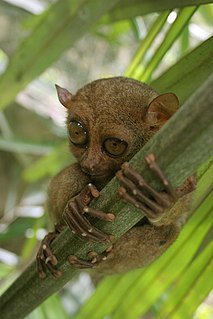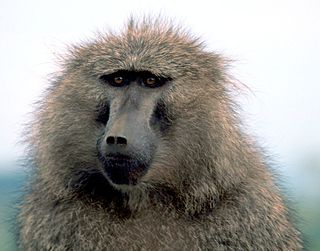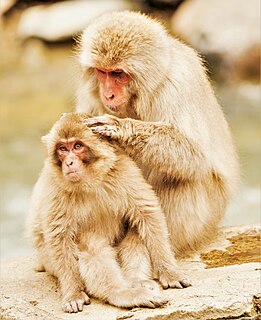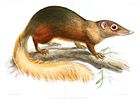
A primate is a eutherian mammal constituting the taxonomic order Primates. Primates arose 85–55 million years ago first from small terrestrial mammals, which adapted to living in the trees of tropical forests: many primate characteristics represent adaptations to life in this challenging environment, including large brains, visual acuity, color vision, a shoulder girdle allowing a large degree of movement in the shoulder joint, and dextrous hands. Primates range in size from Madame Berthe's mouse lemur, which weighs 30 g (1 oz), to the eastern gorilla, weighing over 200 kg (440 lb). There are 376–522 species of living primates, depending on which classification is used. New primate species continue to be discovered: over 25 species were described in the 2000s, 36 in the 2010s, and three in the 2020s.

Primate is a title or rank bestowed on some important archbishops in certain Christian churches. Depending on the particular tradition, it can denote either jurisdictional authority or (usually) ceremonial precedence.

The aye-aye is a long-fingered lemur, a strepsirrhine primate native to Madagascar with rodent-like teeth that perpetually grow and a special thin middle finger.

Tarsiers are haplorrhine primates of the family Tarsiidae, which is itself the lone extant family within the infraorder Tarsiiformes. Although the group was once more widespread, all of its species living today are found in Maritime Southeast Asia, specifically the Philippines, Malaysia, Indonesia, and Brunei.

Primatology is the scientific study of primates. It is a diverse discipline at the boundary between mammalogy and anthropology, and researchers can be found in academic departments of anatomy, anthropology, biology, medicine, psychology, veterinary sciences and zoology, as well as in animal sanctuaries, biomedical research facilities, museums and zoos. Primatologists study both living and extinct primates in their natural habitats and in laboratories by conducting field studies and experiments in order to understand aspects of their evolution and behavior.

Apes are a branch of Old World tailless simians native to Africa and Southeast Asia. They are the sister group of the Old World monkeys, together forming the catarrhine clade. They are distinguished from other primates by a wider degree of freedom of motion at the shoulder joint as evolved by the influence of brachiation. In traditional and non-scientific use, the term "ape" can include tailless primates taxonomically considered monkeys, and is thus not equivalent to the scientific taxon Hominoidea. There are two extant branches of the superfamily Hominoidea: the gibbons, or lesser apes; and the hominids, or great apes.

New World monkeys are the five families of primates that are found in the tropical regions of Mexico, Central and South America: Callitrichidae, Cebidae, Aotidae, Pitheciidae, and Atelidae. The five families are ranked together as the Ceboidea, the only extant superfamily in the parvorder Platyrrhini.

The rhesus macaque, colloquially rhesus monkey, is a species of Old World monkey. There are between six and nine recognised subspecies that are split between two groups, the Chinese-derived and the Indian-derived. Generally brown or grey in colour, it is 47–53 cm (19–21 in) in length with a 20.7–22.9 cm (8.1–9.0 in) tail and weighs 5.3–7.7 kg (12–17 lb). It is native to South, Central, and Southeast Asia and has the widest geographic range of all non-human primates, occupying a great diversity of altitudes and a great variety of habitats, from grasslands to arid and forested areas, but also close to human settlements. Feral colonies are found in the United States, thought to be either released by humans or escapees after hurricanes destroyed zoo and wildlife park facilities.

Strepsirrhini or Strepsirhini is a suborder of primates that includes the lemuriform primates, which consist of the lemurs of Madagascar, galagos ("bushbabies") and pottos from Africa, and the lorises from India and southeast Asia. Collectively they are referred to as strepsirrhines. Also belonging to the suborder are the extinct adapiform primates which thrived during the Eocene in Europe, North America, and Asia, but disappeared from most of the Northern Hemisphere as the climate cooled. Adapiforms are sometimes referred to as being "lemur-like", although the diversity of both lemurs and adapiforms does not support this comparison.

Haplorhini, the haplorhines or the "dry-nosed" primates, is a suborder of primates containing the tarsiers and the simians, as sister of the Strepsirrhini ("moist-nosed"). The name is sometimes spelled Haplorrhini. The simians include catarrhines, and the platyrrhines.

Lemurs are wet-nosed mammals of the superfamily Lemuroidea, divided into 8 families and consisting of 15 genera and around 100 existing species. They are native only to the island of Madagascar. Most existing lemurs are small, have a pointed snout, large eyes, and a long tail. They chiefly live in trees (arboreal), and are active at night (nocturnal).

The Japanese macaque, also known as the snow monkey, is a terrestrial Old World monkey species that is native to Japan. They are colloquially referred to as "snow monkeys" because some live in areas where snow covers the ground for months each year – no other non-human primate is more northern-living, nor lives in a colder climate. Individuals have brownish grey fur, pinkish-red faces, and short tails. Two subspecies are known.

Lemuriformes is an infraorder of primate that falls under the suborder Strepsirrhini. It includes the lemurs of Madagascar, as well as the galagos and lorisids of Africa and Asia, although a popular alternative taxonomy places the lorisoids in their own infraorder, Lorisiformes.

The simians, anthropoids or, higher primates are an infraorder of primates containing all animals traditionally called monkeys and apes. More precisely, they consist of the parvorders New World monkeys (Platyrrhini) and Catarrhini, the latter of which consists of the superfamilies Old World monkeys in the stricter sense (Cercopithecidae) and apes.

The pygmy marmoset, genus Cebuella, is a small genus of New World monkey native to rainforests of the western Amazon Basin in South America. It is notable for being the smallest monkey and one of the smallest primates in the world, at just over 100 grams (3.5 oz). It is generally found in evergreen and river-edge forests and is a gum-feeding specialist, or a gummivore.

Monkey is a common name that may refer to most mammals of the infraorder Simiiformes, also known as the simians. Traditionally, all animals in the group now known as simians are counted as monkeys except the apes, a grouping known as paraphyletic; however in the broader sense based on cladistics, apes (Hominoidea) are also included, making the terms monkeys and simians synonyms in regard of their scope. Monkeys are divided into the families of New World monkeys (Platyrrhini) and Old World monkeys.

Lorisoidea is a superfamily of nocturnal primates found throughout Africa and Asia. Members include the galagos and the lorisids. As strepsirrhines, lorisoids are related to the lemurs of Madagascar and are sometimes included in the infraorder Lemuriformes, although they are also sometimes placed in their own infraorder, LorisiformesGregory, 1915.

Experiments involving non-human primates (NHPs) include toxicity testing for medical and non-medical substances; studies of infectious disease, such as HIV and hepatitis; neurological studies; behavior and cognition; reproduction; genetics; and xenotransplantation. Around 65,000 NHPs are used every year in the United States, and around 7,000 across the European Union. Most are purpose-bred, while some are caught in the wild.

Teilhardina was an early marmoset-like primate that lived in Europe, North America and Asia during the Early Eocene epoch, about 56-47 million years ago. The paleontologist George Gaylord Simpson is credited with naming it after the French paleontologist, Jesuit and philosopher Teilhard de Chardin.
Events from the year 1512 in Ireland.
























